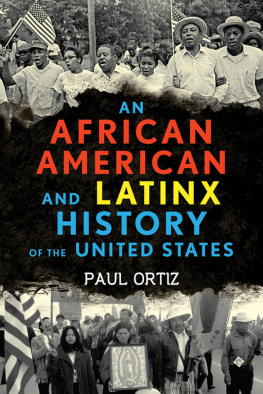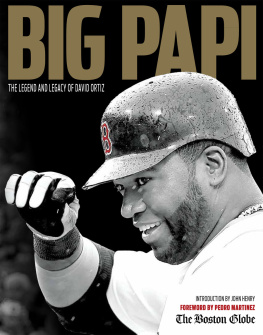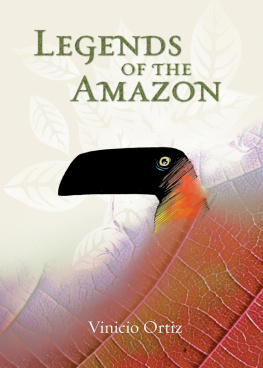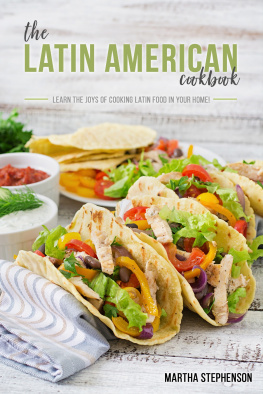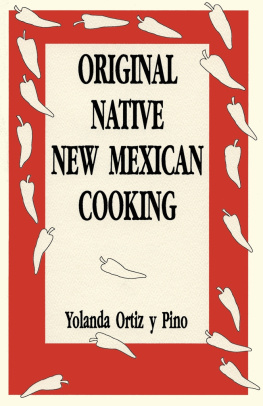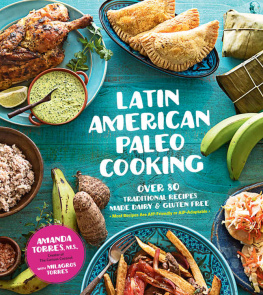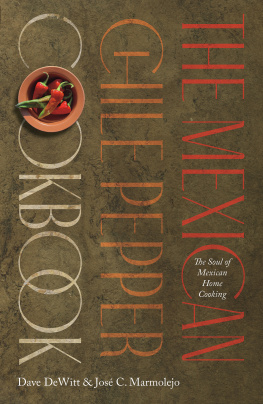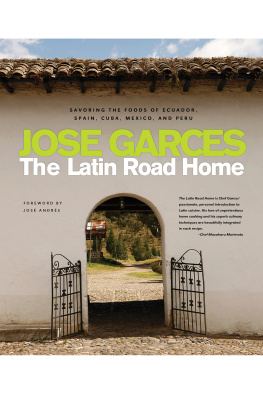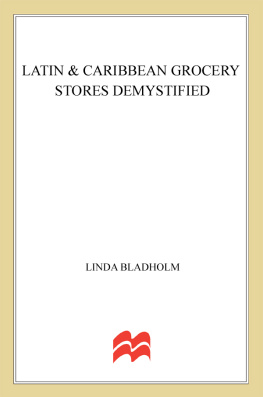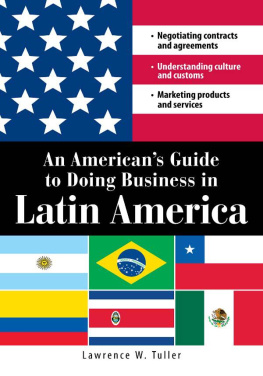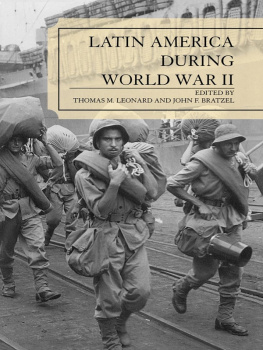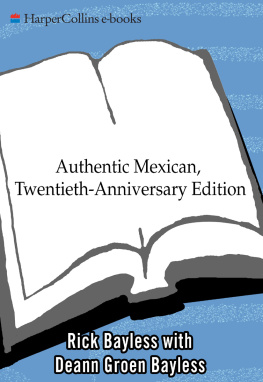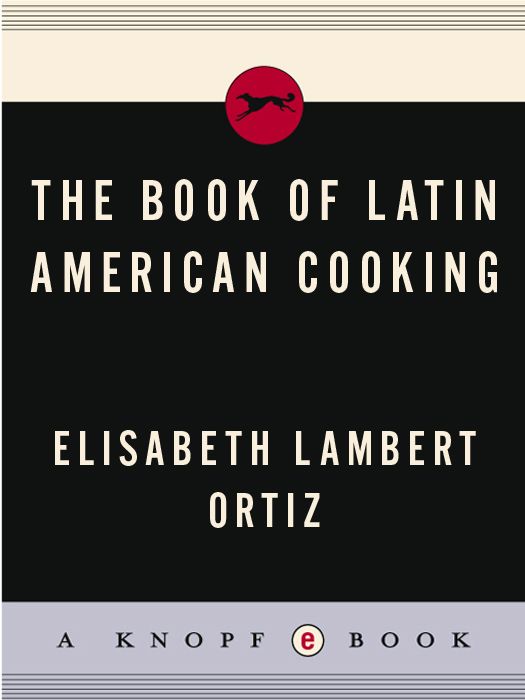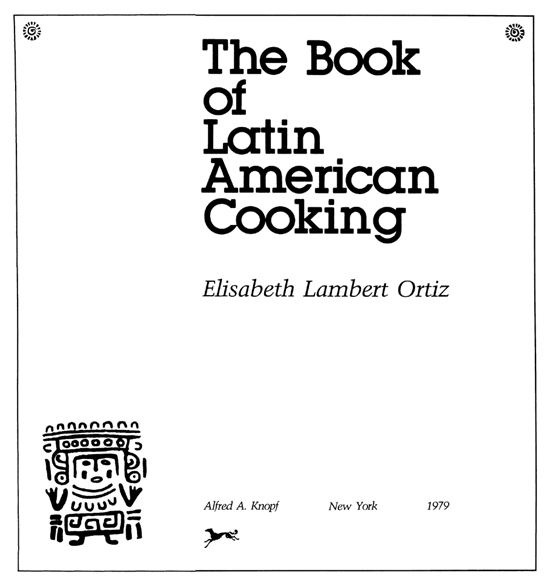THIS IS A BORZOI BOOK
PUBLISHED BY ALFRED A. KNOPF, INC.
Copyright 1969, 1971, 1973, 1974, 1975, 1977, 1979 by Elisabeth Lambert Ortiz
All rights reserved under International and Pan-American Copyright Conventions.
Published in the United States by Alfred A. Knopf, Inc., New York, and simultaneously in Canada by Random House of Canada Limited, Toronto. Distributed by Random House, Inc., New York.
Some of the recipes in this book first appeared in House & Garden magazine, copyright 1969 by The Cond Nast Publications, Inc., and in Gourmet magazine in July, September, and October 1969, September 1971, December 1973, January and December 1974, October 1975, and December 1977.
Library of Congress Cataloging in Publication Data
Ortiz, Elisabeth Lambert [date]
The book of Latin American cooking.
1. Cookery, Latin American. I. Title.
TX716.A1077 641.5978 78-20601
eISBN: 978-0-307-82224-6
v3.1
For my husband and colleague, Csar Ortiz-Tinoco,
whose knowledge and enthusiasm were of
inestimable help in writing this book,
and for Judith Jones, most perceptive and helpful of editors
Contents
Hors dOeuvres and Appetizers
Entremeses
Soups
Sopas
Fish and Shellfish
Pescados y Mariscos
Meats
Carnes
Poultry
Aves
Substantial Dishes
Platillos Fuertes
Vegetables and Salads
Verduras y Ensaladas
Breads and Desserts
Panes y Postres
Sauces
Salsas
Drinks
Bebidas
Acknowledgments
It is hard to know where to begin with thanks. Surely no one has had friends more generous with their time, their knowledge, and their kitchens than I have had. I would like to thank Mr. and Mrs. Jos Fernndez de Crdoba, Mr. and Mrs. Belisario Fernndez de Crdoba, Mr. and Mrs. Arturo Montesinos, Mr. and Mrs. Galo Plaza, Col. and Mrs. Edmundo Garca Vivanco, Mr. and Mrs. Vincente Umaa Mndez, Margarita Pacini, Cecilia Blanco de Mendoza, Mr. and Mrs. Guillermo Power, Jorge Manchego, Mr. and Mrs. Genaro Carnero Checa, Noreen Maxwell, Dr. and Mrs. Alberto Gormaz, Alejandro Flores Zorilla, Mr. and Mrs. Salvador Ferret, Dr. Ral Nass, Mr. and Mrs. Carlos August Len, Simn Reyes Marcano, Raymond Joseph Fowkes, Lolita de Lleras Codazzi, Phyllis Bird, Emma Vsquez, Mirtha Stengel, Mr. and Mrs. Gilberto Rizzo, Mr. and Mrs. Ral Trejos, Mara J. Troconis, Jeanne Lesem, Jos Wilson, Copeland Marks, Lua de Burt, Josefina Velilla de Aquino, Mara Teresa Casanueva, Mr. and Mrs. Abl Quezada, Mr. and Mrs. Humberto Ortiz Reyes, Humberto Ortiz Azoos, Mr. and Mrs. Hctor Fernndez, Mr. and Mrs. Efran Huerta, Dr. and Mrs. Antonio Delgado, Raquel Braune, Victor Simn Bovier, Alwyne Wheeler, James A. Beard, Mr. and Mrs. Victorino A. Althaparro, Dr. Ral Noriega, Dr. and Mrs. Andrs Iduarte, Elizabeth Borton de Trevio, Mr. and Mrs. Julio Csar Anzueto, Lucy de Arenales, Mr. and Mrs. Jason Vourvoulias, Mr. and Mrs. Mario Montero, Ruth Kariv, Mr. and Mrs. Antonio Carbajal, Mr. and Mrs. Eugenio Soler Alonso, Ambassador and Mrs. Mario Alvrez, and Alan Eaton Davidson CMG.
I am deeply indebted to Dr. David R. Harris of London University and Dr. Wolfgang Haberland of Munich for their scientific findings on the origins of agriculture in Latin America and for their advice and encouragement, and to Walter Sullivan, who first brought this new work to my attention. My thanks to my friend and colleague the late Dr. Alex D. Hawkes for helping me with botanical problems relating to tropical plants and herbs. I am immensely grateful to Alan Davidson, that great authority on fish and shellfish and writer of cookbooks on the subject, and to Alwynne Wheeler of the British Museum of Natural History, who both helped me on the identification of the chilean fish congrio.
I would have been lost without the work done by Dr. Jorge Hardoy, of Argentina, and Dr. Leopoldo Castedo, of Brazil, who make brilliantly clear the urban nature of the great civilizations of pre-Columbian Latin America. I owe them a great debt.
My thanks also to Sally Berkeley at Knopf for the marvelous job she did in helping to find illustrative material for this book and to Karolina Harris, the designer, for her imaginative selection and placement of the illustrations.
Elisabeth Lambert Ortiz,
New York
Introduction
I first became interested in Latin American food when I was at school for some time in Jamaica. It was the flavor of hot peppers that beguiled me, especially one that Jamaicans call a Scotch bonnet small, lantern-shaped, fiery, and flavorful. I also had Cuban and Brazilian friends who gave me a tantalizing glimpse into this enormous cuisine that stretches from the Rio Bravo (Rio Grande) to the Antarctic. It wasnt until shortly after I was married, twenty odd years ago, and my husband was transferred from headquarters in New York to another United Nations assignment in Mexico, that I was able to pursue my research into flavors I have never been able to forget. So it was chance that I started with Mexico, perhaps the most complex and unique cooking of the whole region. Even now, when I have traveled to all the worlds continents, Mexican food is still the most exotic of all.
Mexican cooking still rests firmly on its Aztec, and to a lesser extent Mayan, origins, interwoven with the cooking of Spain. But Spain itself was for almost eight hundred years dominated by the Arab empire, so its food has a strong Middle Eastern influence. All through my investigation of Mexican cooking I kept stumbling into the Middle East. Later on I went to the Middle East, Spain, and Portugal to sort out the influences. So many strands are woven into this complicated tapestry that I still find it hard to unravel them completely.
But no matter the sources, the reward is in the eating. From the start I was enchanted by the dishes of the corn kitchen, the most purely Mexican aspect of the food. My palate was utterly bewitched by simple snacks like quesadillas de flor de calabaza where an unbaked tortilla is stuffed with a savory mixture of cooked squash blossoms, folded over, and fried, or more rarely, baked. I had mouth-watering deep-green peppers stuffed with mashed beans, batter-coated, and fried; or even more exotic, stuffed with meat and masked with a fresh cheese and walnut sauce and garnished with pomegranate seeds. I had huachinango a la Veracruzana, beautiful red snapper with mildly hot jalapeo peppers in a tomato sauce very lightly perfumed with cloves and cinnamon. And Mole Poblano de Guajolote, that extraordinary mixture of different types of dried peppers, nuts, herbs, spices, and a little bitter chocolate made into a sauce for turkey and originally a favorite dish at Moctezumas court. It was wholly unfamiliar, wholly delicious.
I found wonderful descriptions of the markets of pre-Conquest Mexico in the monumental work of a Spanish priest, Fray Bernardino de Sahagn, who was there before the Conquest was consolidated. A lively writer, he brought the markets to life, even describing how the local prostitutes lounged about, clicking their chewing gum. I hadnt realized that


